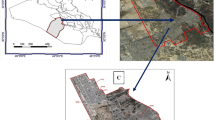Abstract
Groundwater is an important decentralized source of drinking water. Being underground, it is relatively less susceptible to contamination. In addition to domestic needs, it is extensively used for irrigation and industrial purposes. It is therefore necessary to implement groundwater recharge systems by capturing the rainwater runoff. In the present study, GIS-based hydrological assessment of watershed has been used to identify the potential sites for locating the groundwater recharge structures. Based on land use, soil and topography, rainfall runoff modelling was carried out in GIS for a sub-watershed of River Kanhan, in Nagpur District, Maharashtra State, India. Five potential sites with maximum flow accumulation were delineated using the rational method for peak runoff estimation. As the groundwater recharge potential also depends on the geological and geomorphological characteristics of land, analytic hierarchy process (AHP) with expert’s judgement was used for ranking the sites. The criteria considered in AHP were geological features, i.e. lineament density, depth to bedrock and soil cover; geomorphological features, i.e. drainage density, slope, landforms and land use/land cover; and water table level fluctuation. The site P5 with maximum flow accumulation and sandstone rock formation was ranked first. The site P1, where catchment has well-developed drainage and geological formation shows rock with secondary porosity, was ranked second.





Similar content being viewed by others
References
Bellver JA, Mellado VC (2005) An application of the analytic hierarchy process method in farmland appraisal. Span J Agric Res 3(1):17–24
Bonham-Carter GF (1996) Geographic information systems for geosciences, modeling with GIS. Pergamon, Love Printing Service Ltd., Ontario, p 398
CGWB (2007) Manual on artificial recharge of groundwater. Central Groundwater Board, India
Gangodagamage C, Clarke AC (2001) Hydrological modeling using remote sensing and GIS. In: Twenty-second asian conference on remote sensing, Singapore, pp 5–9
Gawande RR, Srivastava AK, Jeyaram A (2002) Geological, geomorphological, hydrogeological and land use/land cover studies around Kamthi area, Nagpur District, Maharashtra, using remote sensing techniques. J Indian Soc Remote Sens 30(1 & 2):95–104
Nagpur District Geology and Geomorphology (2008) http://www.nagpuronline.com/nagpurcollectrate/geology.htm. Accessed date: August 2008
NBSS & LUP (1994) Land resource atlas, Nagpur District, Nagpur, Maharashtra. Publication 22
Olivera F, Maidment D (1999) Geographic information systems (GIS)-based spatially distributed model for runoff routing. Water Resour Res 35(4):1155–1164
Raju KCB (1998) Importance of recharging depleted aquifers: state-of-the-art artificial-recharge in India. J Geol Soc India 51:429–454
Ramaswamy S (2007) The groundwater recharge movement in India. In: Giordano M, Villhoth KG (eds) The agricultural groundwater revolution: opportunities and threats to development. CAB International, Wallingford
Ramaswamy SM, Anbazhagan S (1997) Criteria and techniques of detecting site-specific mechanisms for artificial-recharge––a case study from Ayyar basin, India. J Geol Soc India 50:449–456
Ravi Shankar MN, Mohan G (2005) A GIS based hydrogeomorphic approach for identification of site-specific artificial-recharge techniques in the Deccan Volcanic province. J Earth Syst Sci 114(5):505–514
Robinov CJ (1989) Principles of logic and the use of digital geographic information systems. In: Ripple WJ (ed) Fundamentals of geographic information systems compendium. American Society for Photogrammetry and Remote Sensing, Bethesda, pp 61–80
Saaty TL (1994) Fundamentals of decision making and priority theory analytic hierarchy process (AHP). RWS Publications, Pittsburgh
Saraf AK, Choudhury PR (1998) Integrated remote sensing and GIS for groundwater exploration and identification of artificial-recharge sites. Int J Remote Sens 19(10):1825–1841
Singh P (2004) Engineering and general geology. Kataria and Sons Publishers, New Delhi, pp 428–430
Stuebe MM, Johnston DM (2007) Runoff volume estimation using GIS techniques. J Am Water Resour Assoc 26(4):611–620
Thanesuen S (2007) Application of analytic hierarchy process on preferable speed limit for logistics company: a case study on Hokkaido roads. Can J Transport 1(2):87–98
Tideman EM (1996) Watershed management: guidelines for Indian conditions. Omega Scientific Publishers, New Delhi
Wong G (1999) Multi criteria decision AID for building professionals. J Build Survey 1(1):1–5
Acknowledgments
The work was carried out under the project GIS-based modelling study. The financial assistance received from the Department of Science and Technology for the project is acknowledged with thanks.
Author information
Authors and Affiliations
Corresponding author
Rights and permissions
About this article
Cite this article
Sargaonkar, A.P., Rathi, B. & Baile, A. Identifying potential sites for artificial groundwater recharge in sub-watershed of River Kanhan, India. Environ Earth Sci 62, 1099–1108 (2011). https://doi.org/10.1007/s12665-010-0598-z
Received:
Accepted:
Published:
Issue Date:
DOI: https://doi.org/10.1007/s12665-010-0598-z




